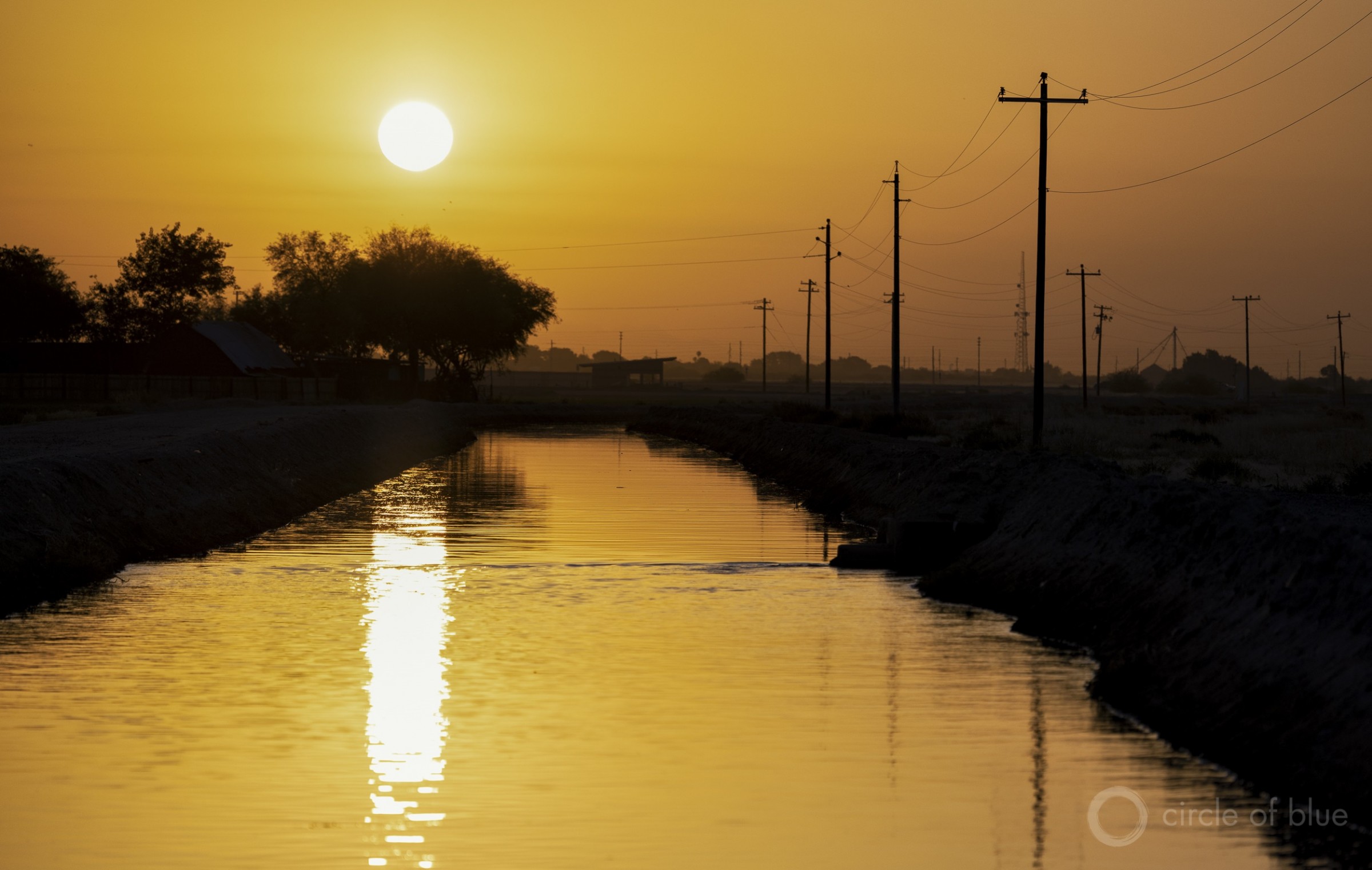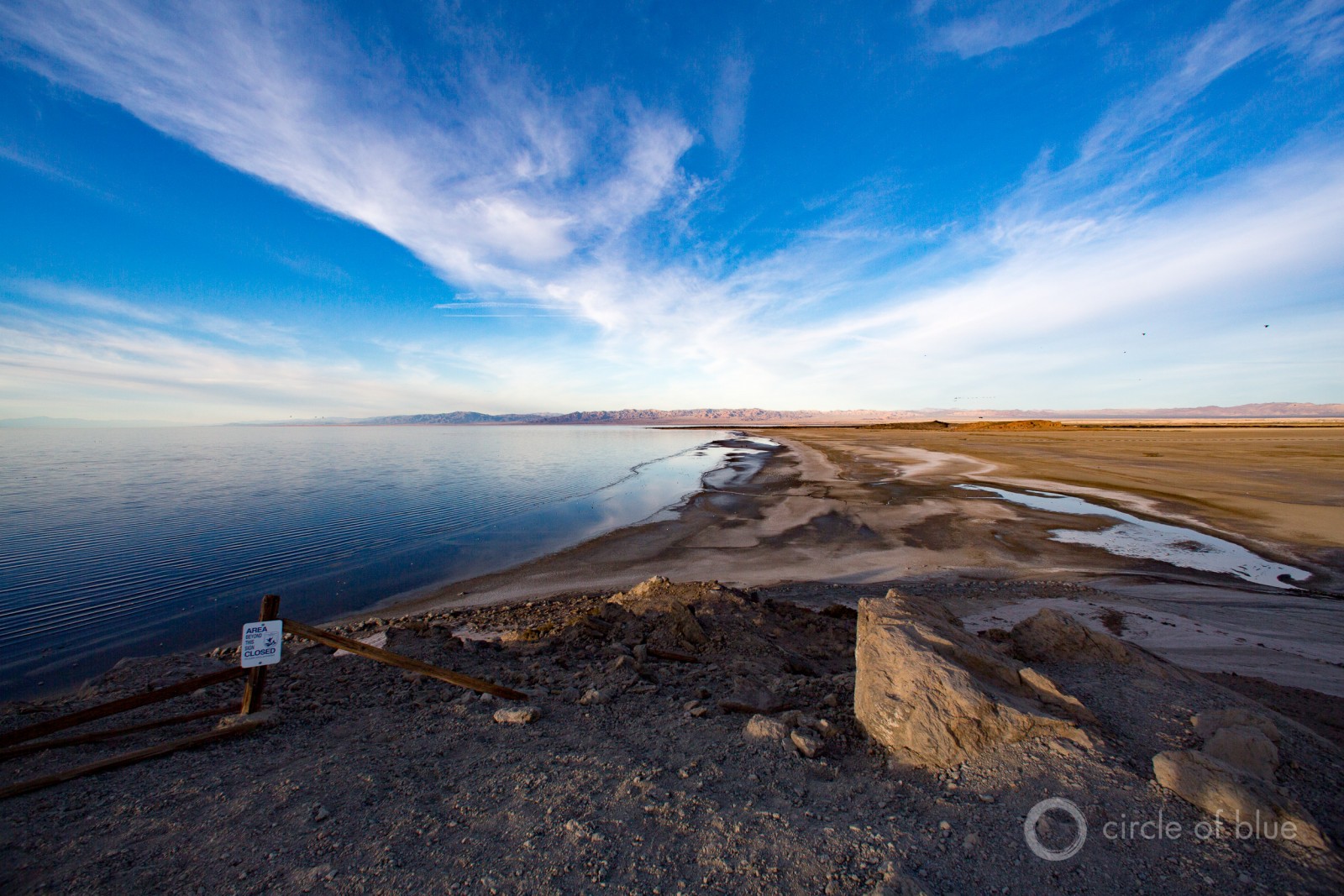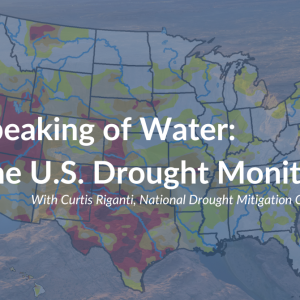The Inflation Reduction Act provides the agency with more than twice its annual budget for drought response. How might the funds be spent?

The sun illuminates a canal in Buckeye, Arizona. Photo © J. Carl Ganter/Circle of Blue
By Brett Walton, Circle of Blue – August 11, 2022
- The Inflation Reduction Act provides the Bureau of Reclamation $4 billion for drought response.
- The House is expected to move quickly on the Senate-passed bill.
- The bill outlines three spending categories for the drought-response funds.
On the morning of August 4, Patrick Dent, the Central Arizona Project’s assistant general manager for water policy, briefed his board, updating the water supply agency’s caretakers about basin-wide discussions to reduce Colorado River water use.
Near the end of his remarks, Dent mentioned an idea circulating among farm districts in southern Arizona and California to help protect depleted reservoirs upstream. The farmers, holding some of the largest, most secure rights to the waning river, proposed forgoing a portion of their allotments in exchange for cash compensation. The numbers were just a sketch, but the dollar figures in play were in the billions.
“That kind of funding is not readily apparent in the moment,” said Dent, who stated that a compensation package of that magnitude would not be possible without federal contributions.
A few hours later — and a few thousand miles eastward — that funding suddenly materialized.
To secure her vote for a major Democratic Party priority — a $369 billion climate, spending, and tax reform bill that will be the largest federal investment in clean energy programs — Arizona Sen. Kyrsten Sinema requested additional money for the drought emergency in the western states.
Her colleagues obliged, and on August 7 the Senate passed the Inflation Reduction Act, which includes $4 billion for the Bureau of Reclamation to respond to dry conditions in the American West, with special emphasis on the Colorado River and other basins in long-term drought. The bill also adds $550 million to provide reliable household water service to disadvantaged communities in the region. It builds on a five-year, $8.3 billion allocation in the federal infrastructure bill for drought response.
The unveiling of the Inflation Reduction Act lit a fuse in Washington, just before the lazy days of the August recess. Speaker Nancy Pelosi said that the Democratic-majority House would “move swiftly” to pass what she characterized as a “landmark” piece of legislation. The House is expected to vote on the bill on Friday.
With its drought provisions, the bill focuses attention on the Bureau of Reclamation. An agency under the purview of the Department of the Interior, Reclamation manages dams, river systems, and irrigation infrastructure in 17 western states. The $4 billion dollars in the Inflation Reduction Act is more than double its annual budget.
It’s certainly a large chunk of money, said Jennifer Gimbel, senior water policy scholar at the Colorado Water Institute at Colorado State University. But it is “a drop in the bucket for what is needed” to address a growing aridity that now covers more than 70 percent of the West in some stage of drought.
The gap between needs and available dollars means Reclamation will have to be selective when distributing funds.
The text of the Inflation Reduction Act provides some direction, but it is both mercifully brief and maddeningly vague. It outlines three spending categories for the $4 billion.
The first option is to pay water users not to divert water. This is the objective of the Arizona and California farmers. The second is to reduce water demand and use through conservation and efficiency projects like drip irrigation. A third possibility is to restore ecosystems and habitats impaired by drought. The shrinking Salton Sea, a priority for California’s Imperial and Riverside counties, could be eligible.

The salinity of the Salton Sea now is almost twice as high as that of the ocean. Photo © J. Carl Ganter / Circle of Blue
These options reflect ideas already under debate. Farmers in southern Arizona have floated a plan along with counterparts in California that could reduce irrigation withdrawals from the lower Colorado River by as much as 925,000 acre-feet. Farmers in the Yuma area are pressing for payments of $1,500 per acre-foot of water that they forgo.
Their request — and the focus on the Colorado River — is a reflection of precarious times. Camille Touton, the commissioner of the Bureau of Reclamation, “set down the gauntlet” in the basin in June, when she ordered two million to four million acre-feet of water cuts in the next year, said Mark Limbaugh, president of The Ferguson Group, a lobbying firm that counts western irrigation districts among its clients.
Limbaugh, who served as the Interior Department’s assistant secretary for water and science in the George W. Bush administration, said that Touton’s conservation decree amounted to a statement of priorities: protecting lakes Mead and Powell from catastrophic declines is paramount. “If they spend money on something that doesn’t do that, it’s not going to solve their problem,” he told Circle of Blue.
Reclamation declined to respond to questions about the agency’s decision-making process for allocating the funds. Rob Manning, chief of public affairs, said that the agency does not comment on pending legislation.
Gimbel, who oversaw water and science policy at the Department of the Interior in the Obama administration, said she would rely on what already works. “If I were Reclamation, I’d want to go with processes that are tried and true,” she said.
Gimbel pointed to two existing programs that Reclamation could draw upon. One is WaterSMART, a program that takes grant applications for projects to secure reliable water supplies. Another is the system conservation program piloted in the Colorado River basin to store conserved water in Lake Mead.
Ferguson noted that the bill directs Reclamation to rely on existing laws and authorizations.
According to Kevin Moran of the Environmental Defense Fund, a problem Reclamation might face as it doles out money is the tension between immediate action and long-term benefits. Paying farmers not to farm saves water now. Installing more efficient irrigation equipment or lining canals results in structural changes in water use that could reverberate decades into the future.
“We have to engage quickly in the near term,” Moran told Circle of Blue. “But we also need to accelerate what we’re doing on a large scale to promote long-term water use reductions and resilience.”
Reclamation’s decisions will be closely watched, especially along the Colorado River, where the Imperial Irrigation District is the largest single water rights holder. The district in the far southeastern corner of California holds rights to nearly as much water from the river as the state of Arizona.
JB Hamby, an IID board member, told Circle of Blue that the district is willing to forgo water deliveries. But only as long as there is a commitment to mitigate damage to the Salton Sea. A sump for farm runoff, the inland Salton Sea has been shrinking because of declining inflows. Less irrigation water means less runoff. As the lake recedes it is becoming saltier, harming fish. More lakebed dust and salts are then exposed to the wind.
Hamby said that district leaders are still assessing what they think is reasonable compensation that accounts for all costs due to water cuts. Those costs include not only reduced farm earnings, but also less income for farm supply companies and workers and less money circulating in community businesses.
“We don’t want to damage our communities by not receiving funding to cover the impacts,” Hamby told Circle of Blue.
Brett writes about agriculture, energy, infrastructure, and the politics and economics of water in the United States. He also writes the Federal Water Tap, Circle of Blue’s weekly digest of U.S. government water news. He is the winner of two Society of Environmental Journalists reporting awards, one of the top honors in American environmental journalism: first place for explanatory reporting for a series on septic system pollution in the United States(2016) and third place for beat reporting in a small market (2014). He received the Sierra Club’s Distinguished Service Award in 2018. Brett lives in Seattle, where he hikes the mountains and bakes pies. Contact Brett Walton




